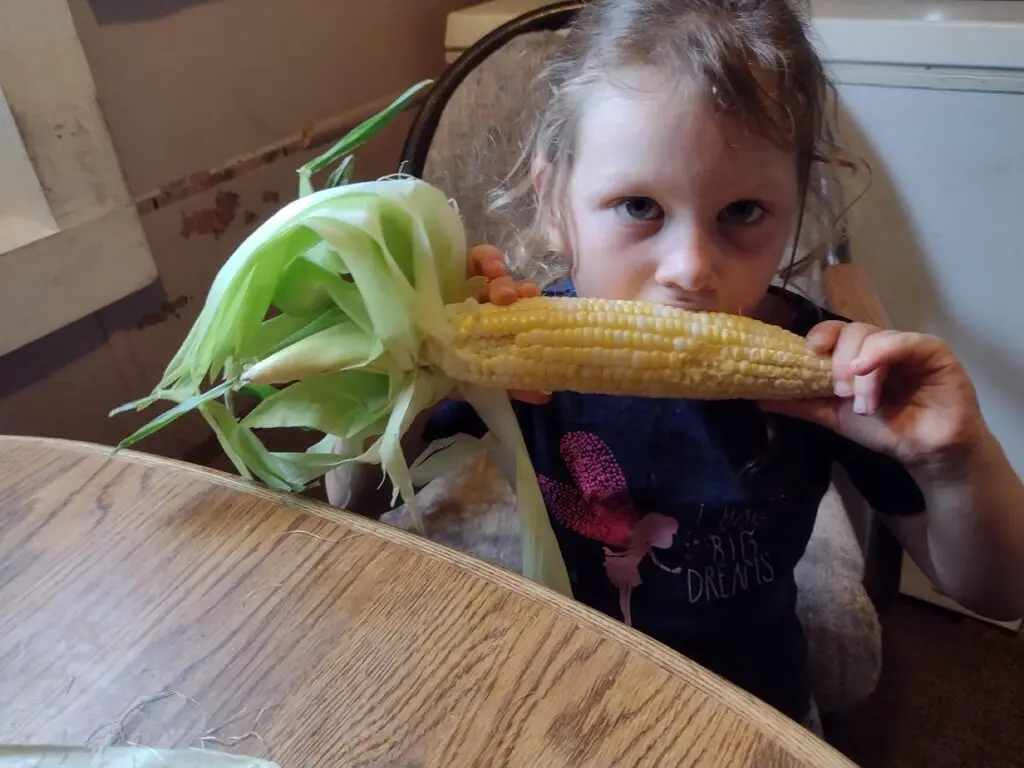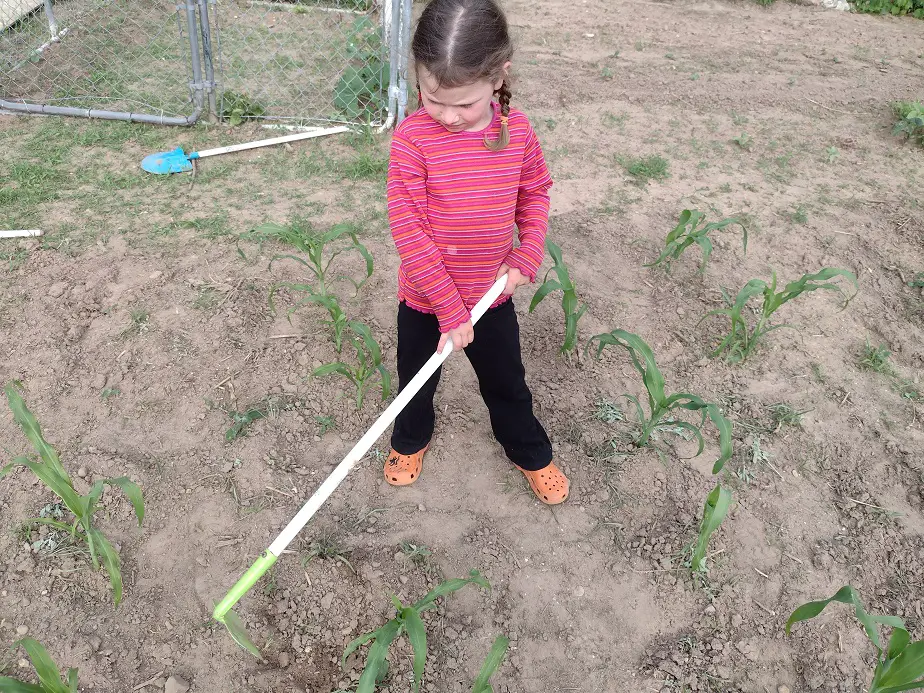Corn is a single species with 6 main variations. Although, these two make up almost all of the US corn supply. While both are nutritious, they couldn’t be more different.
Sweet corn is high-sugar, low-starch corn usually eaten young. Field corn, also called dent corn, is a low-sugar, high-starch grain that’s harvested mature and dry. Sweet corn is bred for high sugar content and color, while field corn is bred for its feed value and the by-product industry.
That’s the short answer, but there’s a lot more. And, I have a few things you probably didn’t know so be sure and keep reading.
The Difference Between Sweet Corn and Field Corn
First, let’s start off with the technical differences. As the corn grows and the ears develop, the plant produces water-soluble sugars, mainly sucrose, through photosynthesis which are transported throughout the plant. These sugars, upon reaching the ears, undergo a unique conversion process.
The kernels contain special storage cells that absorb the water-soluble sugars, convert them to less soluble starches, and store them within each seed. Only thing is, sweet corn actually tries to skip that last part. Technically, it’s a naturally occurring genetic mutation (something happened and genetic information got lost).
The mutation, being bred in by inbreeding, resulted in a new variety of corn. Basically, a healthy functioning sweet corn plant lets unconverted sucrose into the kernels and doesn’t get around to making much starch. You could say it does, just at a much lesser level.
Now, add to that corn specifically bred for extra sugar, and you get a very sweet tasting ear of corn. But, as soon as it’s picked, the sugars no longer flow and what’s there gets steadily converted into starch. Sweet corn can lose half its sugar in the first 24 hours after picking.
That’s why Super fresh sweet corn is way better than what was picked last week, stored in a cooler, and shipped to the grocery store.
Moden field corn is general use corn bred specifically for the US production market. That’s a market that is heavily bent on high-starch animal feed, cornstarch by-products, and corn ethanol production. Most of the field corn is bred for toughness and high yield.
There are some bred for more of a specific use, but most are for general use. Field corn, aka dent corn, hasn’t really changed a lot since it was first cross-bred out of several very old corn varieties. Most of the work on it has been on disease resistance and increasing productivity.
Field corn still has sucrose in it. In fact, the field corn I grew and picked fresh had as much sugar as the sweet corn I bought at the grocery store. Remember, sweet corn loses its sugar quickly. Most field corn has 2-4 percent sugar in it. picked at peak time, it can have up to 5 percent sugar.
That’s really a lot of sugar. But, there’s also a lot of starch in the kernels that water down the sweet flavor. If I pick field corn before the maximum starch stage, it’s pretty enjoyable on the cob.
Sweet corn in the grocery store is generally around 4-5 percent sugar (by dry weight). Generally, we figure sweet corn has twice, or so, the sugar of field corn. But, all corn has more sugar when freshly prepared just before entering the final stage of plan maturity.
Let me sum it up: Sweet corn kernels are filled with sugary water and contain little starch. Field corn kernels quickly convert the sugary water into stored starch and have more net calories.
When to Pick Sweet Corn
Sweet corn is picked 70-80 days after planting, in good growing conditions. A reliable indicator of ripeness is the silks turning brown. You can measure the ripeness with a refractometer, or by examining the clarity of liquid from a kernel. Cloudy liquid indicated ripeness and liquid means unripe.
Growing conditions will make a big difference to the overall maturity date for your corn. Cooler weather or a lot of cloudy days can add a week or so to the growing time. Dry weather, drought conditions, or stunted plants may mature faster because of stress-induced maturity. That’s not a good thing.
That literally means the plant is giving up and saying “I quit”. That’s a sign of weak and/or unhealthy plants, so it’s not a good way to get early sweet corn. Stunted plants don’t produce much sugar because there’s less photosynthesizing green plant material.

How to Grow the Sweetest Sweet Corn
Healthy, well-fed plants and quality seeds grow the sweetest sweet corn. The biggest factors in sweetness are proper plant nutrition and proper harvest time. Freshness greatly affects the sweetness of sweet corn.
Honestly, the best thing you can do for awesome sweet corn is build up healthy soil. I can’t stress enough how important that is. Soil health is a thing that most gardeners and farmers are tempted to overlook. How often have you done a soil nutrient test? How often have you measured soil organic matter?
More importantly, have you ever measured soil microbiology? Soil microbiology is what makes things work. Without a good biological and microbial system, fertilizers don’t work, soils erode, and plants wither and die. So, let’s talk about soil health for a minute.
If you want to measure your soil’s biological health, all you really need to do is watch for earthworms. one expert agrologist told me ” in all my years studying and working with soils, I learned that worm count is the most effective method of measuring soil biology health”.
The benchmark is 5 worms per full shovel of dirt. If you have that, your soil is undoubtedly pretty good. if not, work it up. Adding organic matter like manure, compost, or untreated mulches really helps the soil. Tilling as little as possible also goes a long way to rebuilding the soil.
If possible, avoid more than 10 consecutive days of bare soil. I plant cover crops in the fall and spring before corn planting, then lightly till the soil to kill the cover crop a few days before corn planting time. Multiple studies have shown that healthy, living soil makes the best-tasting produce. I’ve also seen a number of studies showing that no-till soil (usually healthier soil) produces better-tasting foods.
How to Fertilize Sweet Corn
For home gardeners growing sweet corn, use between 3 and 5 lbs. 13-13-13, or 1.5-2.5 lbs. Miracle Grow per hundred square feet. Sweet corn uses a lot of nitrogen, potassium, phosphorus, magnesium, and calcium. Be sure all major minerals are in the soil before the corn is two feet tall.
You need to do a soil test to see where your soil is before planting and when the corn is a foot tall. I highly recommend the Luster Leaf 1602 Soil Test Kit. that’s the only home soil test I’ll use. Anyway, test your soil in early spring to get an idea of how fertile it is.
With that test kit, it should show N and K high or in excess, and P in the middle or a bit above. If it shows your soil is depleted, you need the full dosage of fertilizer. If it’s halfway, use half. Adjust accordingly. Now, different soil types will lose nutrients at different rates from rainfall, groundwater, etc.
You’ll need to test again to see where things are at. When the corn is a foot tall, it’s really starting to need those major nutrients, especially nitrogen. As soon as the tassels appear, it’s nearly done using nitrogen, but still needs the others. Keep the major nutrients in check and supplement them if needed.
Nitrogen and magnesium will leach from your soil quickly. Potassium can too. Phosphorus tends to stay put, and can easily build up to high levels that hurt your soil. Excessive phosphorus will bind other nutrients in the soil, making them unavailable to plants.
If your soil tests high for phosphorus, consider using standard Miracle Grow or look for a lawn fertilizer with little to no phosphorus (P). Fertilizers are usually labeled with three numbers like 13-13-13. That’s nitrogen-phosphorus-potassium or N-P-K. Miracle Grow is a 24-8-16, which is usually great for corn.
Can You Eat Field Corn Like Sweet Corn?
Field corn can be picked and eaten like sweet corn if picked at the right time. Pick it once the silks turn brown and the kernels become filled with a cloudy or milky liquid. Very fresh field corn can have as much sugar as store-bought sweet corn. If picket too early or late, it will taste blander.
Is Field Corn Bad for You?
Field corn is not inherently bad for you. While corn is high in starch, it’s still part of a healthy, balanced diet and is an exceptional whole grain. Although GMO varieties can be concerning, many varieties are simply crossed of old-fashioned varieties. There are many heirloom varieties of field corn still grown.
How to Prepare Field Corn for Eating
Field corn is usually ground into a meal for grits/cornmeal mush or cornbread. Dry kernels can also be roasted or fried, then eaten as a snack food. Field corn also makes delicious corn pudding (Indian Pudding) by cooking cornmeal with water, molasses, and spices.
When did Sweet Corn Originate?
Sweet corn was likely originated by the Iroquis natives in the 1700s. The first mention of it was in a newspaper article from Plymouth in the 1820s referencing the arrival of a new type of extra sweet corn in 1779. History tells us that it quickly spread as fresh eating corn within 20 years.
By the 1820s, sweet corn was popular along the east coast and was quickly spreading abroad. since then, people have been trying to selectively breed it to be sweeter and have a longer period of peak sweetness. Most of the progress has been on the last 50 years due to a better understanding of genetic traits.
Related articles:

